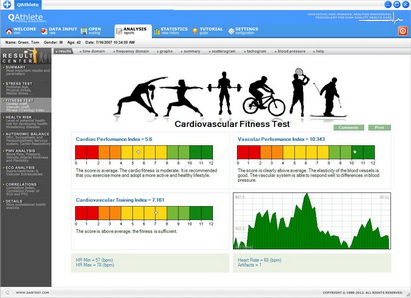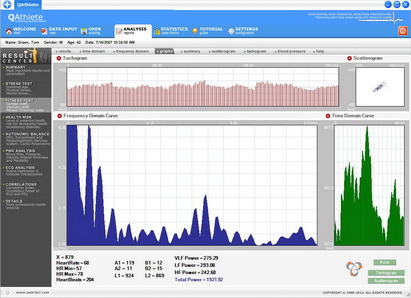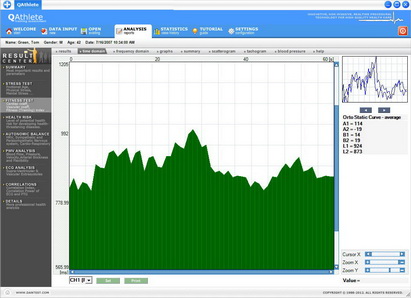Optimize Training and Recovery.
Workouts may not always have the intended effect.
Cardiovascular Vitality Test
Test Overview
It is widely recognized that Orthostatic testing is one of the most effective methods of measuring subtle changes in cardiovascular function, particularly the system's regulatory mechanisms. When performing the Orthostatic test, the patient sits down for several minutes resting peacefully and then stands up. When the body position shifts from supine or seated to standing, specific changes in heart rate and blood pressure occur as a compensatory reaction of the body. Testing helps to assess the ability of both sympathetic and parasympathetic nervous systems to adequately respond to regulatory challenge caused by gravitational shift in the body's blood mass. The test result (i.e. the orthostatic heart rate) is the difference between the heart rates at supine rest and at standing position.
For a healthy individual, standing up as well as maintaining the standing posture for several minutes causes no significant physical exertion. However, if there is subtle cardiovascular deficiency or the functional capacity of the body's regulatory mechanisms is inadequate then this maneuver becomes a significant stressor to the body.
QAthlete Orthostatic testing is the quantitative and qualitative assessment of the fitness and health levels based on HRV analysis. The test is quick and effective and begins with the attachment of simple, noninvasive electrodes, attached as instructed. The candidate is instructed to stand for two minutes followed by sitting for 30 seconds followed by standing for 30 seconds. The full process is repeated alternately for three minutes. The data collected from mean cardio tachogram and spectrum is analyzed to produce eventual results in both quantitative and qualitative format.

Physiological Background
The diagram below describes a physiological process that occurs during the standup maneuver. This process includes two phases.
An Orthostatic Compensation Phase
Changing body posture from seated to standing causes blood volume to rush down to lower extremities due to the gravitational pull. This, in turn, causes an increase in arterial and venous pressure in the lower body and a decrease in blood mass returning to the heart. The central venous pressure drops causing a decrease in stroke volume and cardiac output. Less blood is pumped into the large arteries therefore mean arterial pressure drops.
To avoid dizziness or fainting due to the limited blood supply to the brain, blood pressure in the large arteries decreases to compensate and regulate. The objective of this regulatory mechanism is to achieve normal blood pressure as quick as possible while providing an adequate supply of blood to the vital organs.
A key aspect of this regulatory response is termed baroreflex. Baroreceptors located in the aortic arch wall and both carotid arteries continuously detect changes in mean arterial pressure. Once mean pressure drops (for example, due to standing up) the stimulation to baroreceptors increases and, accordingly, they alert the vasomotor center located in the brainstem. Increased stimulation of the vasomotor center results in an immediate drop in parasympathetic tonus and a rapid increase in sympathetic tonus.
A combination of decreased parasympathetic tonus and increased sympathetic tonus causes rapid increase in heart rate, contractility of the heart muscle and peripheral arterial vasoconstriction. In addition, skeletal muscles constrict thereby forcing blood from over-expanded veins to return to the heart. In total, this process results in an increase of the stroke volume, cardiac output, mean arterial pressure and, ultimately, the body achieves compensation of the cardiovascular deficiency caused by standing up.
An Orthostatic Recovery Phase
Once compensation of the cardiovascular deficiency caused by standing up has been achieved, the body begins a recovery process in search of balance in the new standing condition. In pursuit of equilibrium, heart rate, stroke volume and arterial blood pressure are all lowered.
Stimulation of baroreceptors also decreases which, in turn, reduces stimulation of the vasomotor center in the brainstem, increases parasympathetic activity and decreases sympathetic activity. This complex chain of events finally leads to a gradual decrease in heart rate and contractility which reduces stroke volume, cardiac output and mean arterial pressure to a level appropriate to the new body state.
It is abundantly clear that regulatory mechanisms, which allow the body to adapt to the demands of its environment, are essential to the overall health of the human body. The importance of assessing cardiovascular regulatory ability cannot, therefore, be overstated. The autonomic nervous system, specifically the sympathetic and parasympathetic nervous systems are central to regulatory ability thus it is important to evaluate the efficiency of these systems. The simplest and most effective method for doing so is the standup maneuver.
Test Results
Once the test is recorded the following cardiovascular and HRV parameters are calculated by the software.
HRV Measures Of A Standup Maneuver
The Standup Maneuver Analysis calculates specific HRV parameters describing physiological response of the cardiovascular system to the standup maneuver when body's position is being changed from seated to standing position.
The Following Parameters Are Calculated:
Cardiovascular Tolerance is an indication of the dynamic regulatory reserves of the cardiovascular system. It is evaluated based on HRV parameters calculated by executing the standup maneuver (i.e. a physiological transitory process). The assessment of Cardiovascular Tolerance is based on the comparison of actual calculated value versus predicted value and normative range. This parameter indicates the ability of the cardiovascular system to tolerate physical or emotional challenges. The higher the parameter, the better and more efficient is the system's ability to respond to changes.
Cardiovascular Adaptation is evaluated based on HRV parameters collected during the 5-minute seated-to-standing process. This parameter indicates the ability of the cardiovascular system to adapt to physiological changes caused by physical or emotional challenges. This assessment is based on changes which take place in the autonomic regulatory function in the presence of challenges. The higher the parameter, the better the ability of the cardiovascular system to compensate for and adapt to changes in the body.
Both cardiovascular tolerance and adaptation are indices of cardiovascular regulatory function. If parameters are low and remain below normal for a prolonged period of time, this could connote cardiovascular dysfunction which may simply be a result of poor health or may predicate more serious cardiovascular disorders.
Physiological Basis Of The Vitality Test
Fitness assessment measures the response of the heart-vascular reaction during orthostatic stress (i.e. moving from a seated to a standing position). This response includes vasoconstriction of the peripheral blood vessels (arterioles) and an increase in heart rate. These two regulatory responses protect the brain from a serious decrease in oxygen supply as the body moves from seated to in standing. QAthlete measures and calculates the change in the cardiotachogram and in the frequency spectrum of the cardiointervals during the test. These two factors are dependent upon individual fitness levels which determine the ability of heart and blood vessels to overcome orthostatic stress.
Evaluating a patient's ANS state using QAthlete's Vitality Test before and after any treatment can provide an accurate and reliable evaluation of treatment efficacy. In cardiology, for example, it is important to assess the effectiveness of beta-blockers in order to optimize the therapeutic strategy and in clinical pharmacology, is vital to assess the influence of various medicine on autonomic function. QAthlete Fitness assessment are useful for analyzing the health of those suffering from cardiovascular disorders such as high/low blood pressure, myocardiosclerosis, different types of myocardiopathy, myocardial stroke, heart transplantation, etc. Data gleaned from QAthlete testing can be used to supplement traditional procedures, providing an extensive, comprehensive assessment of the cardiovascular system.
Main Results
Results of QAthlete Vitality Testing are based upon the Time-Domain and the Frequency-Domain analysis. These are the most significant factors in Fitness analysis. The full scope of an individual's fitness condition is presented on a scale depicting fitness level combined with numerical values for the following indices:
* Training (fitness) index
* Cardiac coefficient
* Vascular coefficient
Statistically important relationships exist between the Vitality Test results and the results received from the veloergometric test assessment of maximum work capacity.
QAthlete Fitness Analysis is the result of several years of applied scientific research involving athletes, everyday adults and cardiovascular patients. As a result of this thorough research and testing, conclusions can be drawn regarding correlations between assessment results and associated health risks.
Description Of Vitality Test Results
The following coefficients are calculated from the mean cardiotachogram and the frequency spectrum. Associated health risks can be inferred based upon extensive field research and applied testing.
Cardiac Coefficient
An unfavorable result for this coefficient (i.e. below six relative units) may indicate inadequate heart training as well as any processes which my decrease the intensity of myocardium constrictions.
Vascular Coefficient
An unfavorable result for this coefficient (i.e. below six relative units) may indicate a decreased sensitivity of the baroreceptors. The cause for this includes an increase in blood pressure or the beginning stages of atherosclerosis development.
Training (Fitness) Index
This is the general assessment of the patient's capability to respond to the orthostatic stress requirements. Fitness index values below six (in relative units) are unfavorable and can be the result of immobilization, obesity, recovalescence and other types of diseases affecting the physical condition of the individual.
A statistically important correlation has been determined between the Fitness analysis results and the veloergometric assessment of the maximum working capacity. The advantage of QAthlete Vitality Testing is an easier, faster and safer execution which makes it suitable for mass preventative examinations.
Unfavorable Results Of Fitness Analysis Tends To Be Dangerous
Immobilization and obesity lead to negative physical fitness. This is one of the major factors of increased health risk in terms of cardiovascular and other pathological disorders.



